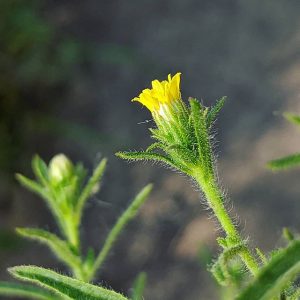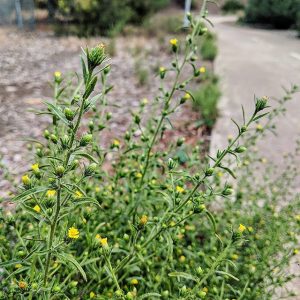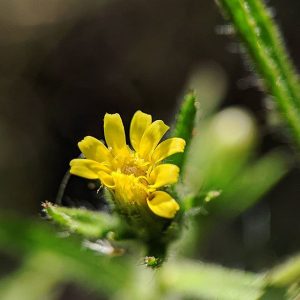Stinkwort (Dittrichia graveolens), an autumn-flowering annual aster with an aggressive aroma and Eurasian origin.
Although the first Australian collection dates to 1876, Stinkwort was spreading in the Adelaide Hills as early as 1870, when it alarmed local councils and was a debated inclusion in successive SA Thistle Acts. Opponents of the bills decried the plant’s inclusion, arguing ‘it was impossible to make the owners of land eradicate stinkwort,’ that ‘it would ruin many a man to do so,’ and that it ‘made a capital feed for sheep’ or was ‘valuable as a green manure’. Columnists amplified these claims, suggesting that ‘if, as is stated, the ploughing-in of the aster will treble the producing capabilities of the soil, it would be a public calamity to discourage its intrusions.’
(Stinkwort’s barbed seeds sometimes produce intestinal injury, a serious problem in Australia’s sheep colonies.)
Little was accomplished. An 1878 newspaper account described the country between Goolwa and Strathalbyn: ‘As far as he could see it was nothing but a green swathe with only two ploughed paddocks in the whole length. There seemed to be no people about, and the country to his eyes had a most desolated appearance… it was remarked that the plant was now in blossom, and if allowed to seed would produce an immense quantity.’
An 1890 letter to the Horsham Times of the impending arrival in Victoria of a plant ‘worse than all other weeds we have to contend with in the Wimmera district.’ Although not formally collected, it had also been reported in southern NSW by 1888, where it was suspected to have caused injury to stock.
By 1892, the plant had been collected in western Victoria and proclaimed under this state’s Thistle Act. In 1897, it was collected at Murrumbeena in Melbourne’s south-east. The same year, it was called ‘the very worst weed with which Victorian and Riverine farms are threatened,’ having already ‘done incalculable harm to the cultivated lands’ in SA.
Today the plant remains widely distributed across the state on disturbed pasturage, cropland and infrastructural margins.
View Original Post on Instagram
Search for information about Dittrichia graveolens in the Flora of Victoria
View information and occurrences of Dittrichia graveolens on the Atlas of Living Australia











